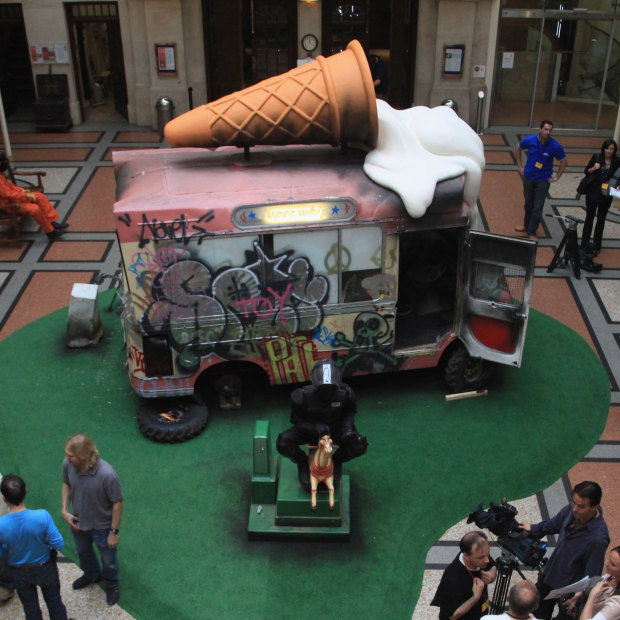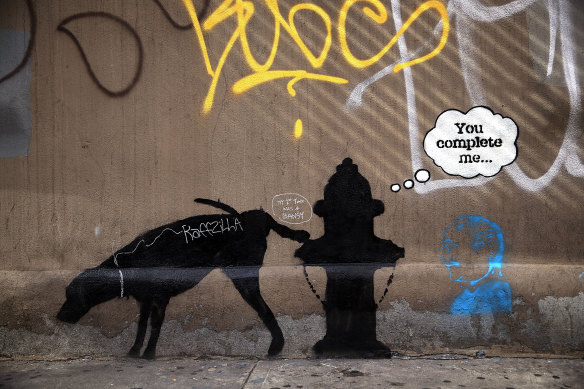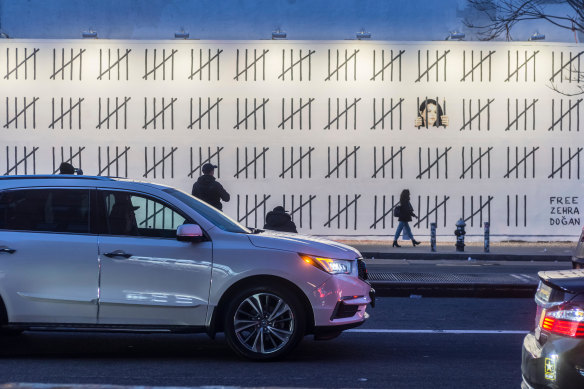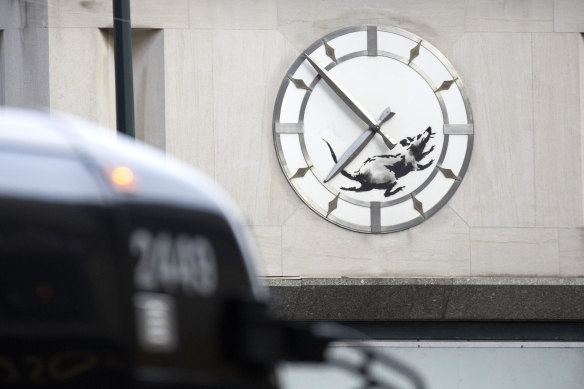This was published 1 year ago
The scoop might have outed Banksy, but I had second thoughts
The chance to unmask the famous street artist presented itself in 2013. Along with it came a host of questions that go to the very heart of art, journalism and our communal need to occasionally not know.
By Nick Bryant

This burnt-out ice-cream van was one of more than 100 works by Banksy at his exhibition in Bristol, UK, in 2009.Credit: Getty Images
Banksy has long been something of a personal fixation. Like me, he comes from Bristol in Britain’s West Country, a two-hour drive along the motorway from London. His early work appeared in Easton, a colourless inner-city neighbourhood of terraced streets and ugly tower blocks, which is where I attended church as a child. Both of us, I suspect, spent our formative years in Margaret Thatcher’s Britain, an era when politics was so raw and so delineating.
Maybe for him as well as me, the 1980 St Pauls riot – the night when the community neighbouring Easton erupted in violence and flames in the first urban riot of a turbulent decade – became a landmark event. Perhaps he can also remember when Easton made global headlines in its own right as the home of Louise Brown, the world’s first “test tube baby”. It was the first time I’d seen a scrum of reporters and snappers camped out on someone’s doorstep. A newborn became a celebrity.
When, in 2009, Banksy secretly took over the city’s Art Gallery and Museum and filled it with more than 100 works, including a burnt-out ice-cream van with a giant melted ice-cream cone on the top and a painting of Thomas the Tank Engine daubed with New York subway-style graffiti, I was flushed with home-town pride. Banksy had put us on the global cultural map. To this day, it thrills me to see tourists hitting the Banksy trail, peering up at his street art on what before had been nondescript walls.
So when Banksy announced a 31-day residency in New York in the autumn of 2013, I could not have been more joyful. Just a few months earlier, I’d taken up residence in the city myself, as the BBC’s New York correspondent. At a quiet time in the news cycle, when Barack Obama was entering the twilight of his presidency and few New Yorkers were paying much attention to the “bridge and tunnel” guy from Queens who would go on to become his shock successor, what could be more fun?

Another Banksy, revealing the thoughts of a fire hydrant.Credit: Getty Images
Each day, Banksy would unveil a new work. A dog peeing on a fire hydrant, with the thought bubble “You complete me”. A New York delivery truck which had been converted into a mobile garden, complete with butterflies, waterfall and rainbows. Most famously perhaps, a pop-up stall on the footpath alongside Central Park, which looked like it was selling cheap Banksy rip-offs for $US60 a pop but which actually was flogging the authentic product, worth tens of thousands of dollars (a New Zealander bought two paintings and later sold them at auction in London for £100,000). In one of the world’s most heavily policed cities, officers from the New York Police Department were determined to arrest him, but he continually managed to outfox them.
Our coverage, which bordered on the hagiographic, was much to Team Banksy’s liking. His PR people even got in touch to say thanks. Maybe as a fellow Bristolian, I said, I could ask a favour. Dumbo, the neighbourhood next to the Brooklyn Bridge where we lived, looked upon itself as an edgy artistic hub. It could already boast a Shepard Fairey, the street artist whose Obama HOPE poster had become so instantly iconic. Maybe Banksy could grace us Dumboites with his graffitied presence. I was told to watch this space.
Days later, Banksy released a video that had obviously been prepared long beforehand, featuring a rebel rocket attack in what looked like Syria on an unidentifiable flying object. When the target was finally revealed, after being shot out of the sky by a surface-to-air missile, it turned out to be the cartoonish baby elephant, Dumbo. Our Bristol bond was consummated.
So began a friendly relationship with his PR team in Britain, which I hoped one day would reap an even richer harvest. If Banksy ever wanted to reveal himself, then his Bristolian admirer at the BBC would be delighted to help perform the unveiling. For years after, I kept in touch with his PR minders. Drinks on the Lower East Side. Installation openings in the Meat Packing District. Pleasure rather than work.

Banksy makes his mark in New York with a mural protesting the incarceration of Kurdish-Turkish artist Zehra Dogan.Credit: Alamy
Then, early one morning in the second year of the Donald Trump presidency, I got a wake-up call from Britain. Banksy was in New York again, his PR team alerted me. A dramatic new work would be released later in the day. I jumped out of bed, rang London and told my news desk to reserve a slot on that night’s main evening news. Presumably, the world’s most provocative artist was about to give us his take on the world’s most powerful man. It was sure to create waves.
The rest of that morning ended up being a waiting game. Not a spray can in sight. Then, approaching lunchtime, Banksy left a clue that announced his presence in town. At the intersection of 14th Street and Sixth Avenue he’d left his signature – a rat running, hamster-wheel-like, within a clock that had been painted onto a former bank scheduled for demolition. Now the artistic scavenger hunt had been joined. Nowhere is the fear of missing out, “FOMO”, more pronounced than in Manhattan. New Yorkers started to give chase.
For us, that Banksy clock was a reminder of our looming deadline. If we were to make the evening news, the unveiling of his Trumpian masterpiece would have to happen soon. So I rang the Banksy PR team and explained our predicament. Head to the Bowery Wall, I was told, a spot where SoHo meets the Lower East Side, which had been made famous in the 1980s by the American pop artist Keith Haring. As luck would have it, our BBC bureau was located at Ground Zero in Lower Manhattan. At a push, we could make it to the Bowery Wall in 15 minutes and beat everyone to the punch.
Sure enough, we were the first to reach the scene, although the freshly painted mural was not what we’d expected to find. Rather than a hit job on president Trump, Banksy had shone a spotlight on a relative unknown. Zehra Dogan was a Turkish-Kurdish artist and journalist who’d been imprisoned by the Turkish authorities for completing a painting of the destruction of a mainly Kurdish town by the forces of President Recep Tayyip Erdogan. Almost Banksy-style, she’d painted bright-red Turkish flags draped over the wreckage. To illustrate her plight, Banksy had produced a stunning work in which the black slashes ticking off the time she’d spent incarcerated doubled as the bars of her cell. But it wouldn’t stir much interest in London. “Worthy but hardly news-worthy” was likely to be the response.
At that very moment, the security guard motioned across the street: “That’s him over there.”
Standing underneath the Bowery Wall, wearing a luminous high visibility jacket and a look of utter bemusement, was a security guard who’d been told by the artist to expect a crowd. “Who paid for you to stand here?” my cameraman and I asked. “What did the painter look like?” At that very moment, the security guard motioned across the street: “That’s him over there,” he said, pointing to a bespectacled middle-aged man wearing a black beanie, brown jacket and grey scarf, who’d just emerged from a coffee shop along with a younger woman, clearly his collaborator. The man was heading for his car, a claret people-mover. We gave chase. The man had levered himself into the driving seat. The woman had put her coffee on the roof and was just about to get in. “Folks, we’re the BBC,” was my jaunty opening gambit, as my cameraman filmed over my shoulder. “Hi, how are you?” I added, trying to sound everyday. As the driver told her to get in the car, I added, rather pathetically: “Sir, I’m a Bristolian.” At that instant, the door slammed, the driver hit the gas, and the car sped off, the woman’s coffee cup still on the roof. About 50 metres further on, the coffee finally flew off – all of which felt fittingly madcap and Banksian. We’d entered the world of journalistic surrealism.

Banksy’s signature running-rat motif.Credit: Alamy
The next hour or so was pretty strange, too. Banksy’s PR team told us that the artist had flown out of the country the previous day, and that we’d merely filmed members of his support crew. But he’d always inhabited a world of smoke and mirrors, and was a master at covering his tracks. Moreover, in 2008, British tabloid The Daily Mail had published a school photo of a man they identified as “Banksy”. He was a Bristolian who they said had gone to a private school and grown up in “middle-class suburbia”. The man we’d seen was a dead ringer for the boy whose photo they’d published. Though we could not know for sure whether the artist we’d filmed was the bona fide Banksy, we could ask the question, with a headline that wrote itself: “Was this a brush with Banksy?” A close-up of the man’s hand gripping his coffee cup showed paint on his fingers – the very colour of the mural on the Bowery Wall.
Now we had to decide what to do with the footage, which involved entering a moral maze. We couldn’t unsee what we’d just seen. Was not our first loyalty, as journalists, to the truth? Another factor to weigh was that his puckish modus operandi was based on playing cat-and-mouse with the authorities and the media, and on this occasion he’d been caught out.
The counter-argument, obviously, was that he’d only been rumbled because his PR team, wanting to do us a favour, had jumped the gun. Bridges would be incinerated. As a fellow Bristolian, I would also feel a horrible sense of betrayal. Would I ever be allowed to return home? But was it our job to protect his identity? We’re not in the business of suppression, after all.
There were big questions to weigh. In outing a street artist who relied on invisibility to carry out his work, would we be guilty of an act of cultural vandalism? Anonymity had always been central to his persona.
One of the BBC’s most senior managers happened to have his daughter with him that day at work, who posited the simple question: “Did we want to be the people who announced that Santa Claus did not exist?” The BBC’s then arts editor, Will Gompertz, was asked to weigh in. At a book festival he’d once asked the audience if they wanted to know Banksy’s true identity: 95 per cent had said they most definitely did not. Here was a mystery of the art world seemingly few wanted to solve. In a culture fixated by fame, namelessness held an even higher currency.
By the time we got back to the bureau, the decision had been made. Institutionally, we did not want to blow the gaffe. It was as simple as that. The possibility of mistaken identity didn’t even enter into it. The discussion did not progress that far. So the footage was put away. Banksy’s work continued unencumbered. We missed out on a global scoop but perhaps we saved ourselves from worldwide ignominy. And I’ve remained a Banksy fan boy, rather than his regretful unmasker.
To read more from Good Weekend magazine, visit our page at The Sydney Morning Herald, The Age and Brisbane Times.